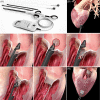Transapical mitral valve repair procedures: Primetime for microinvasive mitral valve surgery
- PMID: 34550618
- PMCID: PMC10078712
- DOI: 10.1111/jocs.16011
Transapical mitral valve repair procedures: Primetime for microinvasive mitral valve surgery
Abstract
Introduction: Nowadays micro-invasive-procedures (off-pump, beating-heart) for mitral valve repair (MVRe) are abruptly expanding with the potential to be adopted as a valuable alternative to surgery. In the present manuscript, the authors review the available technologies intended to treat mitral regurgitation (MR) through transapical approach, including annuloplasty and chordal-repair options.
Annuloplasty: To date, Valcare Amend is the only transapical MV ring to have been implanted in patients. The device allows for stabilization of the annulus through a complete semirigid d-shaped ring. The first-in-human successful procedure was performed in 2016 by our Group and subsequent clinical experience included a total of 14 implanted patients. Currently, the technology is under clinical trial evaluation to validate the efficacy and safety profile of the device.
Chordal repair: Beating-heart chordal implantation via transapical approach is a current feasible, safe and reproducible option. Neochord DS1000 is the most widely used technology in the field, with a solid procedural experience and good results in well-selected patients. Its clinical use has been validated in Europe since 2012, while it is still under clinical investigation in the United States. Harpoon MVRe system is a novel technology, recently CE-mark approved for clinical use.
Discussion and conclusions: Transapical micro-invasive technologies are current viable therapies to treat MR in selected patients. Although there are still several limitations that preclude an extensive use of such procedures, their results are promising in well-selected patients. Embracing transcatheter MVRe therapies should guide the cardiac surgeon through the new revolution of micro-invasive MV tailored repair.
Keywords: clinical review; valve repair/replacement.
© 2021 The Authors. Journal of Cardiac Surgery published by Wiley Periodicals LLC.
Conflict of interest statement
The authors declare that there are no conflict of interests.
Figures




Comment in
-
Microinvasive mitral valve surgery: A new frontier to tackle mitral regurgitation.J Card Surg. 2022 Dec;37(12):4062-4063. doi: 10.1111/jocs.16013. Epub 2021 Oct 4. J Card Surg. 2022. PMID: 34608674 No abstract available.
References
-
- Mahmood F, Karthik S, Subramaniam B, et al. Intraoperative application of geometric three‐dimensional mitral valve assessment package: a feasibility study. J Cardiothorac Vasc Anesth. 2008;22(2):292‐298. - PubMed
-
- Baumgartner H, Falk V, Bax JJ, et al. ESC/EACTS guidelines for the management of valvular heart disease. Kardiologia Polska (Polish Heart Journal). 2017;76(1):1‐62. - PubMed
-
- Enriquez‐Sarano M, Nkomo VT, Michelena HI. Mitral regurgitation. Valvular Heart Dis. 2009:221‐246.
-
- Udelson JE, Stevenson LW. The future of heart failure diagnosis, therapy, and management. Circulation. 2016;133(25):2671‐2686. - PubMed
Publication types
MeSH terms
LinkOut - more resources
Full Text Sources

